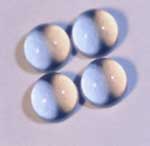

Lightspan Photonics

Index Matching
Lightspan® materials are very effective for index matching of common materials used in Optics. Some common materials, shown in the table below, use the following LS products for index matching.
Material Type |
Acronym |
Refractive Index |
LS Products |
Magnesium Fluoride |
MgF2 |
1.38 |
LS-3238 |
Fused Silica |
|
1.46 |
LS-3246 |
Borosilicate |
BK |
1.52 |
LS1-3252 |
Cyclic Olefin |
COC, COP |
1.52 |
LS1-3252 |
Lenses
Silicone lenses offer photonic device packagers unparalleled compatibility with softer silicone encapsulants. They resist degradation in high temperatures, yellowing under UV exposure and can be molded into unique voptical shapes. NuSil and FMI Inc. have teamed up to provide silicone lenses to the photonics industry. NuSil's Lightspan® line of high quality, optically characterized silicone materials offer different choices for lenses. FMI's Moulding experience with silicones, particularly small intricate parts, can provide customers with quality optical lenses.
 |
Phosphor Coatings
Silicone gels and elastomers can be used as binders for phosphors that are used in the manufacturing of white LEDs. Typically phosphors, like cerium doped yttrium aluminum garnet, with a particle size of 2-20 microns and a density of 4.5 do not remain in suspension in most silicone dispersions. The result is due to the silicone being much lighter, with a density of 1.1. Since the higher viscosity maintains solubility longer, thicker materials, similar to LS-3354, are better in this application.
 |
 |
Inhibition
Lightspan® Brand Gels, Elastomers and Adhesives are designed to provide excellent optical, thermal and mechanical properties. However, some ingredients commonly found in certain adhesives, plastics and elastomers can adversely affect the cure chemistry in these products. NuSil recommends that adhesives, plastics and elastomers be analyzed for cure inhibition prior to selecting the silicone material for use. This evaluation should include materials used in any transfer containers, dispensing hoses, or utensils that come in direct contact with the gel components. For more details read, "Avoiding Cure Inhibition with Lightspan Optical Gels," which is located on our website at: www.nusil.com/WhitePapers/Resources.